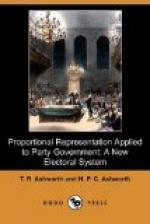EXAMPLE.—Take as an example 13 candidates in a six-seat electorate who poll as follows:—
MINISTERIALISTS.
OPPOSITIONISTS.
BROWN 83,000 YOUNG
53,000
RYAN 74,000 BELL
51,000
COX 44,000 HUME
47,000
WHITE 42,000 JONES
45,000
PEEL 38,000 BLACK
34,000
ADAMS 35,000
-------
GREY 33,000
230,000
SWIFT 21,000
-------
370,000
Total votes = 370,000 + 230,000 = 600,000.
Unit of representation = 600,000/6 = 100,000.
Ministerialists: 3 units + 70,000 remainder = 4 seats.
Oppositionists: 2 units + 30,000 remainder = 2 seats.
The Ministerialists, having the larger remainder, secure the last seat. The successful candidates are Brown, Ryan, Cox, and White (M.), Young and Bell (O.)
It will be noted that without the proportional principle the Ministerialists would have returned two members only, and the Oppositionists four.
It is to be distinctly understood that the simpler plan of voting for half the number of candidates that there are seats is practically as good as the other. In order to show, however, that the plan we have favoured may be simplified, we illustrate by a sample ballot paper a method which has been used in Belgium. Two white spots are printed opposite each candidate’s name. An ink pad and stamp are then provided at each polling booth, and the elector stamps out a white spot for each vote he wishes to give. In the paper illustrated two votes are given to Brown, two to Jones, one to Grey, and one to Swift. This elector has, therefore, given two-thirds of his voting power to the Ministerial party, and one-third to the Opposition, and has thus directly influenced both policies. A further advantage of the proposal is the ease with which such a paper can be read by the returning officer.
BALLOT PAPER
* * * * *
Ministerialists. Oppositionists.
+---------------+ +---------------+ | | | | | | | o o | ADAMS | | o o | BELL | | | | | | | +---------------+ +---------------+ | | | | | | | x x | BROWN | | o o | BLACK | | | | | | | +-----+---------+ +---------------+ | | | | | | | o o | COX | | o o | HUME | | | | | | | +-----+---------+ +---------------+ | | | | | | | o x | GREY | | x x | JONES | | | | | | | +-----+---------+ +---------------+ | | | | | | | o o | PEEL | | o o | YOUNG |




